Many places can reopen now, but "how" matters more than "when"
Different parts of the country are now starting to open back up after the coronavirus lockdowns - and this is drawing a lot of different reactions. Some are protesting for more reopening and greater freedoms, while others are warning that opening too soon will trigger an exponential flare-up and cause thousands of more deaths. Throw in the political polarization in our society, and it seems that people are being driven to a simplistic, binary yes/no position on reopening the country.
The reality is, of course, more complex and subtle. There are two major corrections we must make to a binary understanding. The first is that the United States is a large country, and local conditions vary greatly - and it's the local conditions that will dictate when a particular city or county can reopen. Many places are safe enough now, at least when we look at just the infection numbers. Other places still have a severe infection, and they need to get their numbers down lower. The decision of "when" will need to be made state by state, county by county, and city by city. There is no one-size-fits-all solution. This doesn't mean that I think every locality is doing the right thing: as far as I can tell from just the numbers, Georgia is being a little reckless in reopening too early, and the San Francisco Bay Area is being too cautious in extending its shelter-in-place order until the end of May.
But these concerns pale in comparison to the second, and by far the more important, correction to the reopening question: HOW we reopen matters far more than WHEN. Remember, we need to keep R0 under 1. We need enough social distancing, personal protection, disinfecting, and other such measures, so that each infected person causes less than one additional infection. That's the "how". The question of "when" almost doesn't matter in comparison. If we really get the "how" right, much of the country can open now, or very soon. If we get it really wrong, then it won't matter how long we wait - we'll never be able to safely lift the lockdowns. That's why we must reopen very carefully and deliberately. This is the trickiest part of the whole plan, the part where the "how" is most likely to go wrong.
But more on the "how" later - for now, let's focus back on "when", and look at the data from the different locations.
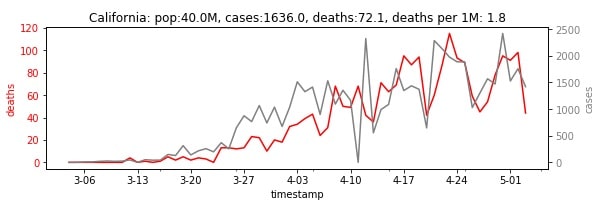
This is a graph of deaths and cases for my home state of California. You see that the numbers have been growing, although they may have plateaued starting around late April. All the graphs in this post use the latest data as of May 4th.
The numbers in the title are each trailing 7-day averages of their per day values. So there have been 1636 new cases and 72.1 deaths per day on average, over the last 7 days.
The most important of these numbers is the "deaths per 1M: 1.8". This says that there have been 1.8 deaths per day per million people in the population, when averaged over the last 7 days. This is the number that tells you the level of risk for the average person in the state of California.
One important point of reference for this number is 0.3 deaths per day per 1M - the risk of dying in a car accident. This is a level of risk that we're quite comfortable accepting. We won't shut down the economy to prevent people from dying in car accidents, so we should accept a similar level of risk from the coronavirus.
In fact, we can actually take on a bit more risk, because we know that the virus mostly kills the elderly, or those with pre-existing conditions. So if you're young and healthy, your risk of death drops by an order of magnitude or more - meaning that you would be able to tolerate numbers up to 3 deaths per day per 1M. With this in mind, I would say that any given locality should be safe to start reopening (slowly, carefully) if they're at or below 1 deaths per day per 1M. Up to 3 deaths per day per 1M may be acceptable, but places with values above that should seriously consider staying locked down until the numbers come down further.
In summary, if the deaths per day per 1M is:
Under 1: Safe to reopen
Between 1 and 3: Be cautious
Greater than 3: Should probably stay in lockdown
This is just a rule of thumb from some simple calculations: local leaders and experts will have more context and data, and you should defer to any such extra information they provide. Furthermore, this doesn't take into account how easy it would be to transmit the disease - even if you're young and healthy and the economy reopens, you should still try not to catch it, because you may pass it on to someone who's more at risk. But this has to do with the "how" of reopening - which, as I said, is far more important, and which I'll discuss later.
Looking at the graph for California, I'd be hesitant about opening up the whole state. The numbers are not yet on a clear downward trend, and the 1.8 deaths per day per 1M people is still a bit too high. But we can do better than looking at the whole state: when we drill down to the county level for the San Francisco Bay Area, we see this:
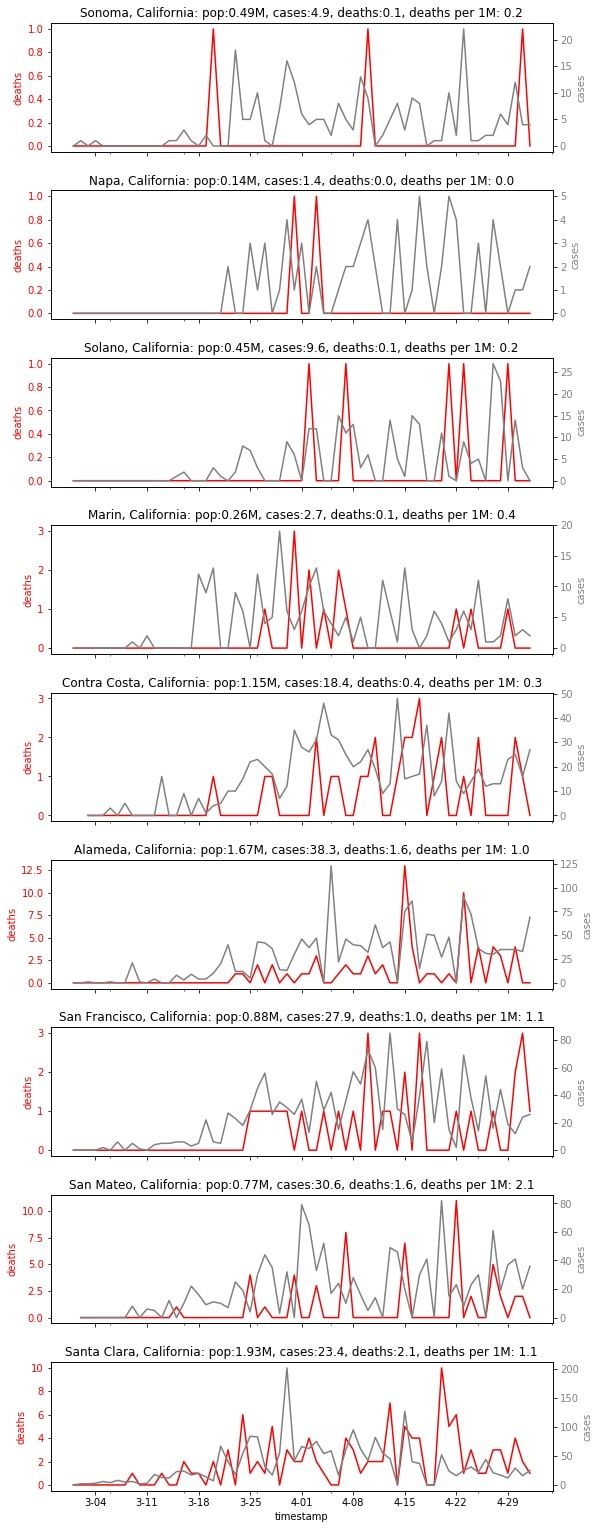
We see that many counties are below 1 death per day per 1M, with a few exceptions. The trends, too, all seem to be flat or decreasing. There are a few worrisome counties, but I would say that the Bay Area as a whole is a good candidate for reopening - although I wouldn't mind waiting another week or two.
What about some other counties in California? Let's look at the Sacramento and Los Angeles counties:
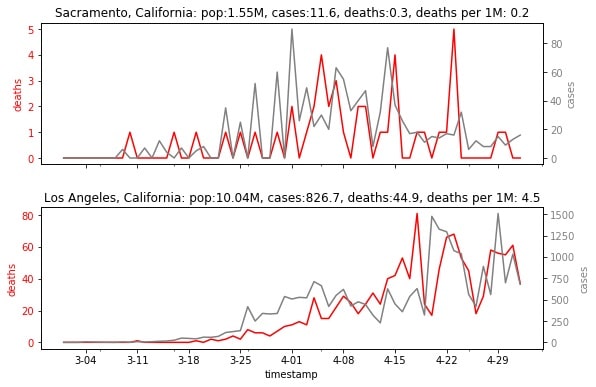
Sacramento is basically fine. With only 0.2 deaths per day per 1M, the coronavirus poses little danger in my state's capital. The trend, too, seems to be distinctly downwards. There was a protest there a few days ago calling for a reopening, and I'm inclined to be quite sympathetic towards them, especially if the reopening is just for the city of Sacramento and not for the whole state.
Los Angeles, on the other hand, should not reopen yet. 4.5 deaths per day per 1M is probably too high of a death rate, and the trend may still be increasing. In fact, we see that Los Angeles is basically responsible for much of the numbers for California as a whole.
We can run similar kinds of analysis for various states as well. Of course, New York and a bunch of other states in the northeast should not reopen yet:

Their deaths per day per 1M are still horrendously bad, and some of their trends are still upwards.
On the other hand, there are also states which are nearly unaffected by the virus:
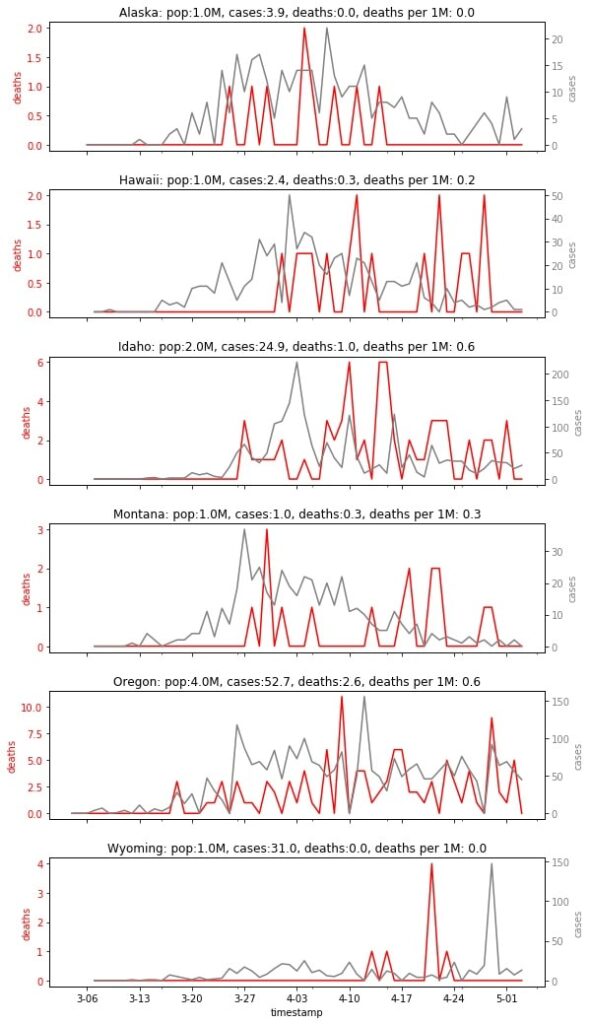
These states are generally safe and they should be able to reopen without putting their people at too bad of a risk, as long as they get the "how" right.
Here are the graphs all 50 states, and their deaths per day per 1M value:
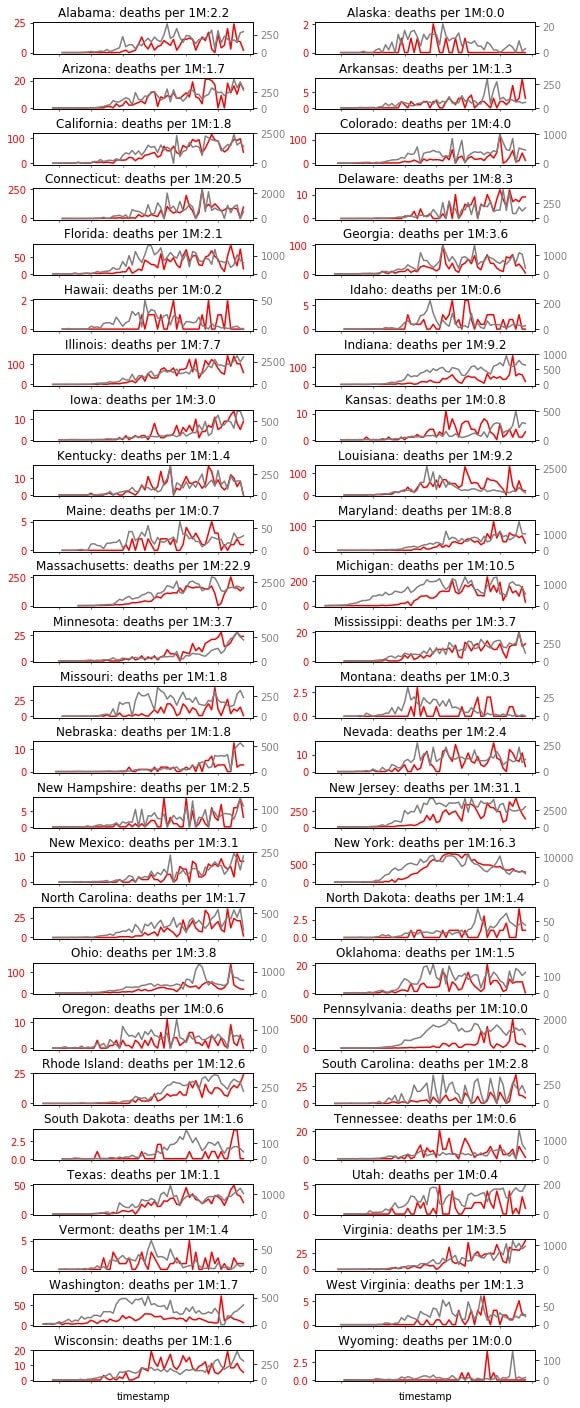
But like we saw with California, all states should really be looked at on a county-by-county, city-by-city level. Furthermore, while this is an important number, it still remains only one of the many factors which enter into when your state can reopen.
So that's the question of "when". Many states are quite safe and can reopen now, and many counties or cities in more iffy states are also safe. There are also areas that are still quite dangerous, which need to stay in lockdown. So the question of "when" needs to be approached with locally. There isn't a binary yes/no answer for the whole country.
But, remember, "how" matters far more than "when". Nothing I said about what areas are safe matter at all, if we get the "how" wrong. And the answer to "how" is simpler: we need to keep R0 under 1. This means doing all the things that you already know about: wash your hands. Don't touch your face. Keep 6 feet of distance from others. Stay home if you're sick. Wear a face mask.
Also consider what additional things you and your communities can do: face shields, in addition to face masks, probably help. You can work from home whenever possible, and you should avoid crowds. A temperature check can be required before entering a building or meeting someone. Hand sanitizers can be placed near commonly used surfaces, like door handles or elevator buttons.
As we progress further we will hear more about other measures that we can take: for instance, it seems that sunlight, heat, and humidity can all help us further fight the virus. If so, then these can all be incorporated into things you can do personally to fight the pandemic.
Some other "how" measures require more of a top-down approach from higher up, like testing (which we still need more of) and contact tracing. But much of the "how" question can be answered at an individual level, with personal responsibility. You are personally responsible for not catching the virus, and for not passing it on if you do.
And that's how we'll beat this thing. Especially as we reopen the economy, remember that the "how" matters more than "when".
You may next want to read:
Leave a Reply
You must be logged in to post a comment.
Post Importance
Post Category
• humanities (25)
• current events (30)
• fiction (10)
• history (35)
• pop culture (14)
• frozen (8)
• math (58)
• personal update (19)
• logic (65)
• science (56)
• computing (16)
• theology (103)
• bible (39)
• christology (10)
• gospel (7)
• morality (22)
• uncategorized (2)